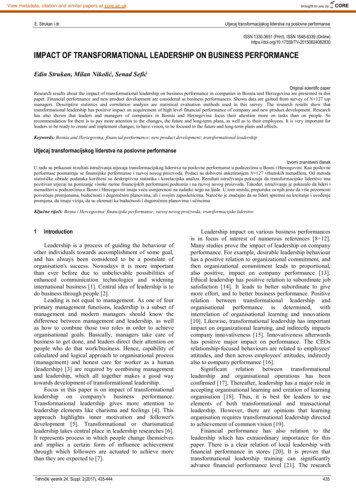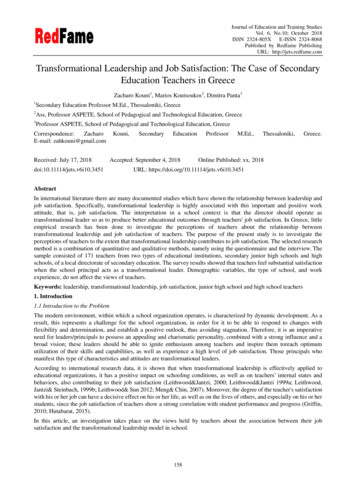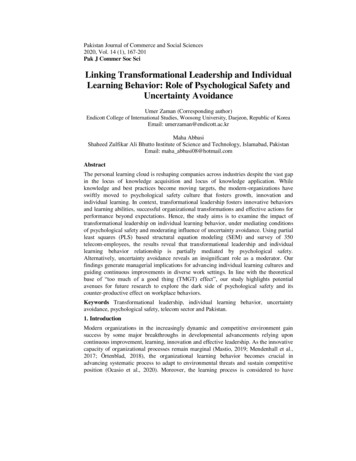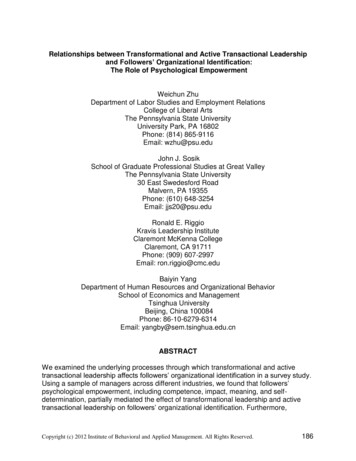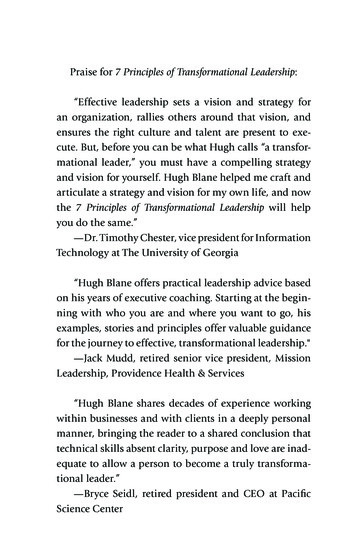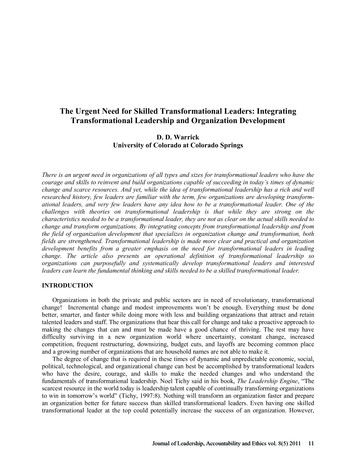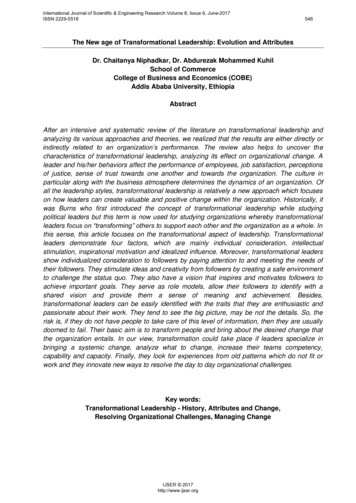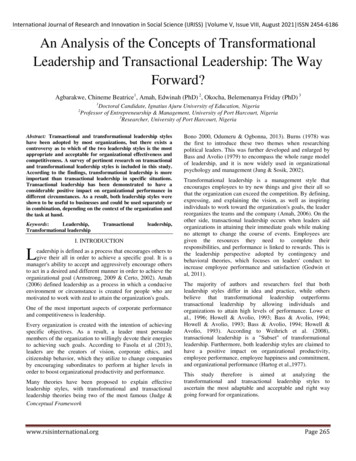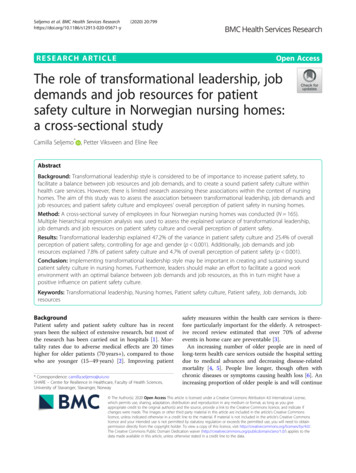
Transcription
Seljemo et al. BMC Health Services (2020) 20:799RESEARCH ARTICLEOpen AccessThe role of transformational leadership, jobdemands and job resources for patientsafety culture in Norwegian nursing homes:a cross-sectional studyCamilla Seljemo* , Petter Viksveen and Eline ReeAbstractBackground: Transformational leadership style is considered to be of importance to increase patient safety, tofacilitate a balance between job resources and job demands, and to create a sound patient safety culture withinhealth care services. However, there is limited research assessing these associations within the context of nursinghomes. The aim of this study was to assess the association between transformational leadership, job demands andjob resources; and patient safety culture and employees’ overall perception of patient safety in nursing homes.Method: A cross-sectional survey of employees in four Norwegian nursing homes was conducted (N 165).Multiple hierarchical regression analysis was used to assess the explained variance of transformational leadership,job demands and job resources on patient safety culture and overall perception of patient safety.Results: Transformational leadership explained 47.2% of the variance in patient safety culture and 25.4% of overallperception of patient safety, controlling for age and gender (p 0.001). Additionally, job demands and jobresources explained 7.8% of patient safety culture and 4.7% of overall perception of patient safety (p 0.001).Conclusion: Implementing transformational leadership style may be important in creating and sustaining soundpatient safety culture in nursing homes. Furthermore, leaders should make an effort to facilitate a good workenvironment with an optimal balance between job demands and job resources, as this in turn might have apositive influence on patient safety culture.Keywords: Transformational leadership, Nursing homes, Patient safety culture, Patient safety, Job demands, JobresourcesBackgroundPatient safety and patient safety culture has in recentyears been the subject of extensive research, but most ofthe research has been carried out in hospitals [1]. Mortality rates due to adverse medical effects are 20 timeshigher for older patients (70 years ), compared to thosewho are younger (15–49 years) [2]. Improving patient* Correspondence: camilla.seljemo@uis.noSHARE – Centre for Resilience in Healthcare, Faculty of Health Sciences,University of Stavanger, Stavanger, Norwaysafety measures within the health care services is therefore particularly important for the elderly. A retrospective record review estimated that over 70% of adverseevents in home care are preventable [3].An increasing number of older people are in need oflong-term health care services outside the hospital settingdue to medical advances and decreasing disease-relatedmortality [4, 5]. People live longer, though often withchronic diseases or symptoms causing health loss [6]. Anincreasing proportion of older people is and will continue The Author(s). 2020 Open Access This article is licensed under a Creative Commons Attribution 4.0 International License,which permits use, sharing, adaptation, distribution and reproduction in any medium or format, as long as you giveappropriate credit to the original author(s) and the source, provide a link to the Creative Commons licence, and indicate ifchanges were made. The images or other third party material in this article are included in the article's Creative Commonslicence, unless indicated otherwise in a credit line to the material. If material is not included in the article's Creative Commonslicence and your intended use is not permitted by statutory regulation or exceeds the permitted use, you will need to obtainpermission directly from the copyright holder. To view a copy of this licence, visit http://creativecommons.org/licenses/by/4.0/.The Creative Commons Public Domain Dedication waiver ) applies to thedata made available in this article, unless otherwise stated in a credit line to the data.
Seljemo et al. BMC Health Services Research(2020) 20:799to be in need of care and treatment in the coming years,resulting in increased pressure on nursing homes. Thismeans that we face new challenges related to the complexity of the health care system, which in turn increasesthe risk of adverse events in health care organisations [7].Focus on patient safety increased following the publication of two reports; “To err is human- building a saferhealth system” by the American Institute of Medicine [8],and “An organisation with a memory” by the UK Department of Health [9]. The reports highlighted the importance of organisational culture as part of the key strategiesrequired to strengthen patient safety. There is no simpleanswer to the question of how health care can becomesafer, but safety culture is considered a key area of focusfor the coming years [7, 10]. Moreover, the results of several studies suggest that there may be a positive relationship between patient safety culture and perceived workingconditions, and positive objective patient outcomes suchas reduction in the frequency of falls and reduced mortality rates, as well as increased patient satisfaction [11, 12].Patient safety culture can be defined as “the product ofindividual and group values, attitudes, perceptions, competencies, and patterns of behaviour that determine thecommitment to, and the style and proficiency of, an organisation’s health and safety management. Organisationswith a positive safety culture are characterised by communications founded on mutual trust, by shared perceptions of the importance of safety and by confidence in theefficacy of preventive measures” [13]. The US NationalPatient Safety Foundation (NPSF) emphasizes leaders’role in establishing and sustaining a patient safety culture as an important focus area in patient safety work[14]. Patient safety culture and leadership washighlighted as fundamental for improving patient safetywhen the Norwegian patient safety program “In safehands 24-7” was established in 2011 [15]. This wasfollowed by new regulations implemented in January2017 by the Norwegian Government, emphasizingleaders’ responsibility to establish a sound patient safetyculture as a part of the overall aim to prevent harm [16].Leaders’ role in creating a culture of safety and in patientsafety work overall has long been considered to be ofkey importance to patient safety [17, 18]. According toMcFadden [19], creating a culture of safety begins withleadership, and transformational leadership is directly associated with creating and sustaining a safety culture.Recent research also shows that transformational leadership is a significant predictor for patient safety culture inNorwegian home care services [20]. The four components characterizing transformational leaders are: idealized influence, inspirational motivation, intellectualstimulation and individualized consideration [21]. Theseleadership characteristics contribute to enabling employees to act beyond their own needs and interests, forPage 2 of 8the greater good of the whole group. The transformational leader will also identify the organizational needsand work to transform the organizational culture, to thebenefit of the organization itself [18]. Based on theoryand previous research, we hypothesize that transformational leadership is positively associated with higherlevels of patient safety culture and overall perception ofpatient safety. Transformational leadership has also beensuggested to positively affect health personnel’s work environment [22]. According to the Job-Demands Resources (JD-R) model by Bakker and Demerouti [23, 24],high levels of job demands lead to increased risk ofburnout. On the other hand, employees may keep upmotivation and reduce risk of burnout if they have sufficient resources in addition to a high degree of job demands. Bakker and Demerouti specifically mention thesupervisory relationship and supportive feedback as important resources. The results of previous studies suggest that work environmental factors related to jobdemands and job resources influence patient safety outcomes [12, 22, 25]. Based on the job-demands resourcestheory and previous literature, we hypothesize that jobdemands are negatively associated with patient safetyculture and overall perception of patient safety. Furthermore, we hypothesize that higher scores on job resources are positively associated with patient safetyculture and overall perception of patient safety.Managers play an important role in balancing job demands and job resources within the workplace [26]. Research suggests that a transformational leadership stylepositively influences nurses’ job satisfaction, work engagement and the psychosocial work environment, which alsoreduces the occurrence of adverse events in clinical practice [22, 27–29]. Adopting a transformational leadershipstyle can also reduce factors related to burnout in nurses[30, 31]. It can prevent them from quitting their jobs andincrease staff well-being and the quality of care. TheAmerican Institute of Medicine [32] recommends leadersto adopt a transformational leadership style in the processof creating optimal working conditions for nurses, whichis essential to prevent accidents and improve patientsafety. We therefore examine the extent to which job demands and job resources may explain the variance in patient safety culture and overall perceptions of patientsafety beyond the impact of transformational leadership.There is limited research on patient safety culture innursing homes, especially in Europe [1]. One previousstudy assessed the association between transformationalleadership, job demands and job resources, and their impact on patient safety culture in Norwegian home careservices [20]. However, no previous studies have explored these associations in nursing homes. The aim ofthis study was to assess the association between transformational leadership, job resource and job demand
Seljemo et al. BMC Health Services Research(2020) 20:799scores; and patient safety culture and employees’ overallperception of patient safety in nursing homes.MethodsA cross-sectional design was used.SampleThe sample consisted of 165 nursing home employees withdifferent professional backgrounds. The majority were female (92%) aged 50 to 59 (30%), and 46% had been workingin nursing homes for more than 10 years (Table 1).Data collectionFour different nursing homes in southwestern Norway participated in the study. A total of 254 healthcare practitionersincluding unit and department managers at first line levelwith personnel responsibilities were invited by email toparticipate in the survey in the spring of 2018. An onlinequestionnaire resulted in a response rate of 65% (N 165).Co-researchers from the Development Centres of NursingHome and Home Care Services facilitated recruitment bycontacting nursing home managers in each participatingnursing home. The selection strategy was purposive, to include a variety of nursing homes with different locations(urban and rural), and with variation in municipality and unitsize. Inclusion criteria were: being employed in minimum30% positions and being able to read Norwegian.Survey instrumentsThe questionnaire consisted of several validated scalesused to measure patient safety culture, transformationalleadership, job demands and job resources, as well asbackground characteristics such as age, gender, occupational status, and years of employment. The scales wereselected due to their suitability to the target group, feasibility (e.g., time to respond), and availability of Norwegian validated versions.Outcome variablesThe patient safety culture was measured using the validated Norwegian version of the Nursing Home Surveyon Patient Safety Culture (NHSOPSC) [33]. This versioncontains a 10-factor model, which has been found to besuitable for Norwegian nursing home settings [33]. ThePage 3 of 8scale was chosen for this study since it is designed specifically to assess patient safety culture within the context of nursing homes, and its Norwegian version hasbeen validated.The scale contains 42 items rated on 5-point Likertscales (from 1“totally disagree” to 5 “totally agree”). Inthe current study, the mean score of all 42 items wasused as an outcome measure of patient safety culture. Inaddition, we used one of the instrument’s general questions to assess healthcare practitioners’ overall perception of patient safety in the nursing home, “Please givethis nursing home an overall rating on patient safety”.Cronbach’s Alpha for the 42 items was .93.Predictor variablesTransformational leadership was measured using TheGlobal Transformational Leadership Scale (GTL) [34]where participants are asked to rank their leader’s behavioron 5-point Likert scales (from 1 “never” to 5 “very often”)on seven items. The scale was chosen for this study since itis well established and previous research suggested good internal consistency [34, 35]. Moreover, it measures the components that are considered essential for a transformationalleader and it has previously been used to assess transformational leadership within a broad range of Norwegian worksettings [35]. Examples of items include “Gives encouragement and recognition to staff” and “Fosters trust, involvement and cooperation among team members”. In thecurrent study, Cronbach’s Alpha was .95.Job demands and job resources was measured usingthe Short Inventory to Monitor Psychosocial Hazards(SIMPH) scale [36], which is in line with the JobDemands-Resources model by Bakker and Demerouti[23]. The instrument contains 24 items that measure jobdemands and job resources on 4-point Likert scales(from 1 “never” to 4 “always”). Job demands consist ofthe following three dimensions: 1) “pace of work” (fouritems); 2) “mental workload” (three items); and 3) “emotional workload” (five items). Examples of items include:“Do you work under time constraints?” (pace of work),“Are there many things to remember in your job?”(mental workload), and “Is your work heavy from anemotional point of view?” (emotional workload). For thethree dimensions in job-demands, Cronbach’s Alpha wasTable 1 Respondents background demographic informationAgeN (%)Position/educationN (%)Years of employmentN (%)20–2920 (12.1)Managerial positions11 (6.7)Less than 1 year20 (12.1)30–3939 (23.6)Min. 3-year education67 (40.6)1–5 years41 (24.8)40–4926 (15.8)High school education79 (47.9)6–10 years27 (16.4)50–5950 (30.3)Assistant (unskilled)3 (1.8)11–15 years24 (14.5)60 30 (18.2)Administrative personnel2 (1.2)16–20 years20 (12.1)Other3 (1.8)21 years 33 (20)
Seljemo et al. BMC Health Services Research(2020) 20:799Page 4 of 8.91 (pace of work), .74 (mental workload) and .75 (emotional workload) respectively. Job resources consist ofthe following three dimensions: 1) “skill utilization” (fouritems); 2) “autonomy” (four items); and 3) “participation”(five items). Item examples include: “Do you learn newthings in your work?” (skill utilization), “Do you have aninfluence on the pace of work?” (autonomy), and “Canyou participate in decisions that affect areas of yourwork?” (participation). Cronbach’s Alpha for the threedimensions in job-resources was .76 (skill utilization),.72 (autonomy) and .75 (participation).AnalysisThe associations between the variables in the study wereexplored using Pearson’s correlation analysis. Hierarchical multiple regression analyses were used to examinethe extent to which transformational leadership, job demands, and job resources predict the outcome variablespatient safety culture and overall perception of patientsafety. This analysis was considered the most appropriate statistics to test our hypotheses, as it allows us to explore the predictive value of all dimensions in total (thewhole model), as well as the relative contribution of eachdimension [37]. Alpha was set to .05. No violations ofnormality, linearity, multicollinearity and homoscedasticity were found. We had no missing values in the dataset, since respondents had to answer each question before proceeding to the next. Statistical analyses were carried out using SPSS (version 25.0).ResultsCorrelation between variablesTransformational leadership, patient safety culture, overall perception of patient safety and job resources (skillutilization, autonomy, participation) were all positivelycorrelated (p 0.001). Work pace and emotional workload were both negatively correlated with patient safetyculture, overall perception of patient safety and transformational leadership (Table 2). However, the mentalworkload dimension did not correlate significantly witheither patient safety culture, overall perception of patientsafety or transformational leadership and was thereforeomitted from the regression analyses to avoid spuriousregression.Hierarchical regression of patient safety cultureIn the hierarchical regression analysis of patient safetyculture (Table 3), the transformational leadership modelexplained 47.2% of the variance when controlling for ageand gender (F change 138.6, p 0.001). Job demands(work pace, emotional workload) and job resources (skillutilization, autonomy, participation) explained an additional 7.8% of the variance in patient safety culture (Fchange 5.4, p 0.001.). The final model explained55.0% of the variance and transformational leadershipwas the strongest predictor for patient safety culture(β .522, p 0.001), followed by skill utilization (β .166, p 0.05), work pace (β .135, p 0.05) and emotional workload (β .126, p 0.05).Hierarchical regression of overall perception of patientsafetyIn the hierarchical regression analysis of overall perception of patient safety (Table 4), the transformationalleadership model explained 25.4% of the variance whencontrolling for age and gender (F change 51.8, p 0.001). Adding job demands and job resources increasedthe explained variance with 4.7% (F change 2.1, p 0.05), but did not result in a significant change to thefinal model. Total explained variance of the final modelwas 30.1%. In the final model, transformational leadership was the strongest predictor (β .447, p 0.001), andthe only additionally significant predictor was emotionalworkload (β .165, p 0.05).DiscussionThe results of this study showed that transformationalleadership was a strong predictor of patient safetyTable 2 Correlation between the variables using Pearson’s correlation coefficient (r)VariablesMSD11 PSCa3.75.5112 TFLb3.57.81.679**13 Work Pace2.38.64 .329** .224**14 Mental workload2.99.58.007 .015.528**5 Emotional workload1.99.43 .332** .212**.333**.272**16 Skill utilization2.80.57.478**.465** .071.213** .233**7 Autonomy2.53.54.347**.327** .200*.036 .203**.360**8 Participation2.54.66.484**.529** .213**.016 .321**.579**.554**4.06.83.667**.501** .231** .015 .273**.257**.244**c9 Overall PS234567891111.278**** Correlation is significant at the .01 level (2-tailed) * Correlation is significant at the .05 level (2-tailed) aPSC Patient safety culture, bTFL Transformationalleadership, cPS Patient safety1
Seljemo et al. BMC Health Services Research(2020) 20:799Page 5 of 8Table 3 Hierarchical regression analysis for variables predicting patient safety culture (N 165)VariableModel 1Model 2βBSE BAge.113.045.031.101Gender.083.158.050 .012Model 3SE BβBSE B.040.023.060.024.022 .023.111.010.018.110.434.037.522**.333.042Work Pace .135* .108.048Emotional workload .126* .149.072Skill 62Transformational R2 Change.018.455**.078***p .05 **p .001leaders are capable of seeing employees’ individual needsand keep them intellectually stimulated, which mightimpact employees’ willingness to acquire new knowledgeand develop new skills. Previous research shows thatthere is an indirect link between safety performance andtransformational leadership through knowledge-relatedjob characteristics [38]. Skills and knowledge are alsoprioritised areas of focus in patient safety work in thecoming years [7, 39].The fact that transformational leadership is a strongerpredictor than job demands and resources, might be aresult of transformational leadership also having a positive effect on the psychosocial work environment. Several other studies found that transformational leadershiphas a positive effect on healthcare personnel’s job satisfaction [27, 29, 40], which seemed to decrease the occurrence of adverse events [22] and improve the quality ofcare [31]. This is also supported by another study whichfound that transformational leadership positively influenced psychosocial resources and thereby made jobculture and overall perception of patient safety. Job demands and job resources were also important for theoutcomes, although with some differences regardingwhich specific factors were most significant.The findings are in line with a recent study in the Norwegian home care setting [20], showing that transformational leadership was a strong predictor for patientsafety culture. Similar to the current study, the job demand ‘work pace’ negatively predicted patient safety culture and job resources were significant predictors inboth studies [20].Due to the complexity of the rapidly changing healthcare services, there is a need for increased knowledgeand skills to ensure the safety of patients. Skill utilizationin Norwegian nursing homes seems to be an importantfactor for patient safety culture. To build and developskills, there is a need for leaders who are open to receivefeedback from frontline workers, in order to expandtheir understanding and gain an overview of the challenges they are facing in daily care. TransformationalTable 4 Hierarchical regression analysis for variables predicting overall perception of patient safety (N 165)VariableModel 1βAgeGenderModel 2BSE BβModel 3BSE BβBSE B .026 .016.050 .055 .022.043 .055 .508.070Transformational leadership.447**.459.085Work Pace .096 .124.096Emotional workload .165* .314.144Skill pation .104 .131.124R2.014.254.301R2 Change.014.240**.047*p .05 **p .001
Seljemo et al. BMC Health Services Research(2020) 20:799Page 6 of 8Strengths and limitationsresources on the different dimensions of patient safetyculture.Overall perception of patient safety was measuredusing a single item. However, the item correlatedstrongly with related concepts, and has been recognizedas reliable outcome measure in previous studies [33, 47].It is important to be aware that the responses on thisoutcome only reflect employees’ perception of patientsafety and not the actual status of patient safety in thenursing homes. Primary health care practitioners are notrequired to routinely collect data on adverse events inNorway. However, we recommend that objective outcomes of adverse events are included in future studies.The cross-sectional design, the relatively small sampleand the low response rate limits the generalizability ofthe findings. However, the heterogeneity of the includedunits (small and large units and municipalities, urbanand rural) are representative for the variability presentbetween nursing homes across the country. Furthermore, the response rate was similar to other Norwegiannursing home studies [48, 49], indicating a general challenge in obtaining high response rates in this setting.The small sample size did not allow for sub-group analyses with different professions, age groups, years of experience or between departments within each nursinghome. Thus, future studies should explore whether theassociations differ between different groups of employees, using a longitudinal design. Another option forfuture research could be to examine whether job demands and resources mediate the effect of transformational leadership on patient safety culture and overallperceptions of patient safety. Due to the small samplesize we could not justify conducting valid path analysesof mediation and moderation effects in this study [50].Structural equation modelling could be used to furtherassess the mechanisms through which transformationalleadership affects patient safety culture.This study has several methodological strengths and limitations. It is the first study investigating the association between transformational leadership, patient safety cultureand overall perception of patient safety in nursing homes.Therefore, this study provides new knowledge about factors that might contribute to improve patient safety culture and patient safety in the nursing home setting.An average score for the patient safety culture wasused, which means that we do not know exactly whichfactors in the culture are most decisive. However, themean score was used due to high correlation and overlapbetween some of the dimensions in NHSOPSC, and because the purpose of the study was to examine the roleof transformational leadership, job demands and job resources on the total patient safety culture. We recommend that future studies explore the contribution oftransformational leadership, job demands and jobConclusionThis study shows that transformational leadership is asignificant and positive contributor to patient safety culture and overall perceptions of patient safety in nursinghomes. Job demands and the job resource ‘skillutilization’ are also associated with the patient safety culture. The findings indicate that leaders have a key rolein creating and maintaining a sound patient safety culture and improving patient safety. Leaders’ efforts in facilitating a good work environment with an optimalbalance between job demands and job resources mightin turn have a positive impact on the patient safety culture. Leaders should acquire knowledge about the transformational leadership style and implement it as astrategy in their overall quality and patient safety improvements efforts.demands more manageable [41]. Supervisor support anda high-quality relationship with the supervisor are suggested to be particularly important resources, enablingemployees to cope with high job demands [24, 42, 43].The transformational leader has the ability to provide individual support and see the employee’s individual needs.The results of this study indicate that transformationalleadership seems to contribute to improve patient safetyculture and patient safety in nursing homes. This also supports national guidelines focusing on management as essential for patient safety culture [15, 39], and the key role ofmanagers in building a safety culture has also beenhighlighted in recent reports and regulations [7, 14, 16, 39].The importance of transformational leadership in creating a patient safety culture might be a key element at atime where healthcare services are continuously changing, and it takes time to implement new regulationsand professional practices. Understanding how to buildsafety barriers due to these change processes is necessaryfor nursing managers in order to sustain a safety culture[44]. Being a transformational leader implies being ableto adapt to every situation and contribute to change thecurrent work culture to improve patient safety. However,Tafvelin, Isaksson and Westerberg [45] found that middle managers who wanted to practice a transformationalleadership style, experienced that the top managementwas an obstacle to change due to lack of support andlimited influence. This may indicate that not only themiddle managers need to adapt their leadership style,but managers and leaders at every level in anorganization should do so. Creating a safety culture requires knowledge of how systems and people interact,and a broader perspective to understand and act uponthe multiple factors that influence the safety culture andpsychosocial work environment [46].
Seljemo et al. BMC Health Services Research(2020) 20:799AbbreviationsNHSOPSC: Nursing Home Survey on Patient Safety Culture; GTL: GlobalTransformational Leadership Scale; SIMPH: Short Inventory to MonitorPsychosocial Hazards; PSC: Patient Safety Culture; PS: Patient Safety;TFL: Transformational leadershipPage 7 of 87.8.AcknowledgementsThanks to Siri Wiig for planning the overall design of the SAFE-LEAD projectand coordinating the project. We want to thank the co-researchers at theDevelopment Centres of Nursing Home and Home Care Services for helpwith recruitment, and the healthcare personnel at the nursing homes for participating in the study.9.Authors’ contributionsER was responsible for data collection. CS conducted the statistical analyseswith input from ER and PV, interpreted the data and wrote the first draft ofthe manuscript. ER and PV critically reviewed and revised the subsequentdrafts. All authors read and approved the final manuscript.12.10.11.13.FundingThe work is part of the project Improving Quality and Safety in Primary Care– Implementing a Leadership Intervention in Nursing Homes and Homecare(SAFE-LEAD Primary Care), which has received funding from the ResearchCouncil of Norway’s programme HELSEVEL, under grant agreement 256681/H10, and the University of Stavanger. The funding body played no role inthe design of the study, data collection, analysis, or in writing the paper.14.15.Availability of data and materialsThe dataset is available on request from the corresponding author.16.Ethics approval and consent to participateThe Regional Committees for Research Ethics in Norway considered that thestudy was not governed by the Health Research Act. The study followed theHelsinki declaration, and was approved by the Norwegian social science dataservices (NSD, ID 54855). All participants gave their informed consent beforeparticipating in the study.17.18.19.Consent for publicationNot applicable.20.Competing interestsNone declared.21.Received: 27 November 2019 Accepted: 20 A
leadership, and transformational leadership is directly as-sociated with creating and sustaining a safety culture. Recent research also shows that transformational leader-ship is a significant predictor for patient safety culture in Norwegian home care services [20]. The four compo-nents characterizing transformational leaders are: ideal-
